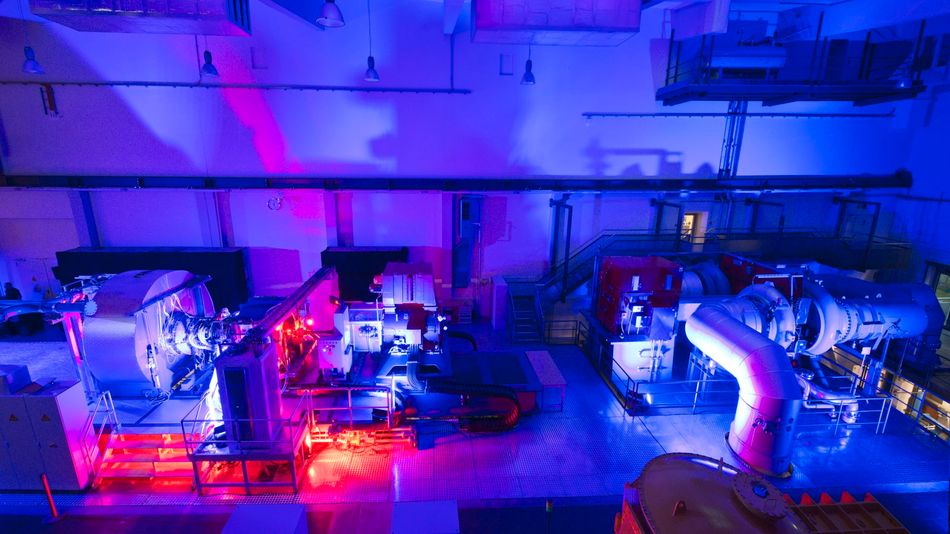DLR and Rolls-Royce Deutschland develop more climate-compatible aircraft engines
DLR and Rolls-Royce Deutschland are developing more climate-compatible aircraft engines.

The DLR turbine test facility 'NG-Turb' Future high-performance turbines are being investigated at the Next-Generation Turbine Test Facility (NG-Turb) at the DLR Institute of Propulsion Technology in Göttingen. Credit: DLR (CC BY-NC-ND 3.0)
This article was first published on
www.dlr.deThe German Aerospace Center (Deutsches Zentrum für Luft- und Raumfahrt; DLR) has made significant progress in developing turbines for efficient and climate-compatible aircraft engines in collaboration with Rolls-Royce Deutschland. Researchers have deployed a trick carried over from many modern aircraft wings: attaching 'winglets' to the tips of the turbine blades to increase engine efficiency. Winglets and other technologies are already being used in the latest Rolls-Royce engines from the Pearl range and have significantly reduced fuel consumption.
Researchers at the DLR Institute of Propulsion Technology in Göttingen worked with Rolls-Royce Deutschland to investigate a new type of two-stage high-pressure turbine. At the Göttingen institute's Next-Generation Turbine Test Facility (NG-Turb), which offers infrastructure unrivalled in Europe, the researchers were able to validate turbine computer simulations from Rolls-Royce. In a turbojet engine, the turbine is positioned after the combustion chamber, from where the emerging exhaust gas jet causes the turbine blades to rotate. The NG-Turb test bed replicates this set up, putting turbines through their paces under real-world engine conditions.
Turbine inlet temperature crucial
The initial measurements on the NG-Turb test stand, conducted as part of the German government's aviation research programme (the LuFo HittTurb project), initially focused on the efficiency of the turbine. As the operating point of turbines varies during take-off, cruising flight and landing, determining the relationship between efficiency and the speed and pressure ratio of the turbine was crucial. "This turbine serves as a demonstrator for various technologies that are to be used in the real engine, including winglets on the rotor blades," says Andreas Pahs, Project Manager of the DLR Institute of Propulsion Technology's Göttingen site. Applying winglets to the blade tips significantly changes the geometry of the blade and hence the flow around it, giving rise to improvements in both turbine and overall engine efficiency.
"We have also carried out detailed flow field measurements," Pahs continues. "We analysed pressure, temperature, flow angle and Mach number using sensors developed in-house here at the institute." The findings were incorporated into the development of Rolls-Royce's Pearl engine range, which powers ultra-long-haul business jets.
Current focus on combustion chamber–turbine interaction
In addition to the new turbine design, the researchers were interested in the influence of the combustion chamber outlet flow on aerodynamics, efficiency and temperature. Given the extreme operating temperatures that turbine materials are subject to, a crucial development task is to identify hot spots early on and target them for cooling by applying cooling air to the turbine blade surface.
In the follow-up project, which was recently completed as part of the EU research programme Clean Sky 2 (an EU Transition project), the scientific research focused on the interaction between the combustion chamber and the turbine. For this purpose, a combustion chamber simulator was developed and installed in front of the turbine on the NG-Turb test stand. The simulator generates flow fields with properties comparable to those from the combustion of conventional fuels and which correspond to the exit profile of a real Rolls-Royce engine combustion chamber.
A better understanding of the temperature distribution at the transition from the combustion chamber to the turbine is key to generating new technology concepts. "Our task is to precisely measure the thermal load within the turbine in order to make the cooling of the turbine blades more efficient," explains DLR Institute of Propulsion Technology project manager Anna-Samira Söhngen. Using targeted, optimised cooling saves on cooling air and further improves overall engine efficiency.
Europe's only hydrogen-ready turbine test bench
The NG-Turb test stand works in a closed circuit with dry air as the flow medium. The stand includes air temperature and pressure regulation, allowing the researchers to set the key parameters of Mach and Reynolds number independently. The system also has an air dryer and a separate air-cooling compressor that diverts flow from the system and supplies it to the turbine for cooling air simulation. The test stand also now includes heat exchangers to lower the temperature of the cooling air and thus allow another parameter, the main-flow to cooling-air temperature ratio, to be set as realistically as possible.
DLR receives financial support from the German Federal Ministry for Economic Affairs and Climate Action (BMWK) to prepare its ground test rigs, including the NG-Turb in Göttingen, for the investigation of climate-compatible fuel and propulsion technologies in aviation (the UpLift project). The focus of the project is on the potential use of hydrogen in engines, the impact of which is also set to be the subject of future investigations in turbine research. The funding is part of the BMWK aviation research programme LuFo Klima, the central government funding instrument supporting the aviation industry on its path to becoming carbon neutral.
Other projects
Another research focus is currently 'hot streak tracking', where researchers measure temperature streaks and their flow through the turbine.

